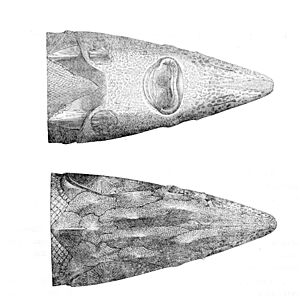European sea sturgeon facts for kids
Quick facts for kids European sturgeon |
|
|---|---|
 |
|
| Acipenser sturio | |
| Conservation status | |
| Scientific classification |
The European sea sturgeon (Acipenser sturio) is also known as the Atlantic sturgeon or common sturgeon. This amazing fish lives in the waters around Europe. It used to be found in large numbers along the coasts of Europe, including the Black Sea and the Baltic Sea.
European sturgeons are special because they are anadromous. This means they live most of their lives in the ocean but travel up rivers to lay their eggs. Sadly, the European sea sturgeon is now a critically endangered species. This means it is very close to disappearing forever.
Contents
What Does It Look Like?
The European sea sturgeon has a head shaped like a wedge, which ends in a long, pointed snout. It has many sensitive whiskers, called barbels, around its mouth. These help it find food. Its back fins are located very far back on its body.
This fish has five rows of large, bony plates along its body. These plates are like armor! Its belly is usually yellow, and its back is a brownish-grey color.
European sturgeons can grow very big. They can reach up to 6 meters (about 20 feet) long and weigh as much as 400 kilograms (about 880 pounds). However, most are around 1.25 meters (4 feet) long. They can live for a very long time, sometimes up to 100 years! They also mature late: males are ready to breed at 12 to 14 years old, and females at 16 to 18 years old.
Where Do They Live?
European sea sturgeons are found along the coasts of Europe. They are not usually found in the far northern parts or the Baltic Sea region. Sometimes, they have even crossed the Atlantic Ocean to reach the coasts of North America!
Like many other sturgeons, they spend most of their lives in salty ocean water. But when it's time to lay eggs, they swim far up into freshwater rivers.
Why Are They in Danger?
Until the early 1900s, there were many European sturgeons in Europe. People caught a lot of them, especially for their eggs, which are called caviar and were considered a fancy food. But too much fishing, called overfishing, caused their numbers to drop very quickly. This started in the late 1800s.
Because of this, they disappeared from most of the places they used to live. Since 1982, they have been a protected species in Europe. Today, they are so rare that they only breed naturally in one place: the Garonne river basin in France.
What's Being Done to Help?
Many people are working to save the European sea sturgeon. Conservation projects include releasing sturgeons that were raised in special fish farms. The first releases happened in 1995. For example, some sturgeons were released into the Rhine river in the Netherlands in 2012 and 2015.
What Do They Eat?
Like other sturgeons, European sea sturgeons use their sensitive barbels to find food. They eat small creatures like worms and crustaceans (like crabs and shrimp) that live on the bottom of the water.
How Many Are Left?
Scientists believe there are fewer than 800 adult European sturgeons left in the wild. The last time they were known to hatch naturally was in the Garonne River in France in 1994. Genetic tests showed that only one pair of sturgeons created all the babies that year.
Because there are so few wild sturgeons, breeding them in captivity and releasing them is super important for their survival. Efforts to bring them back, like releasing artificially bred fish, have been successful in some areas. However, helping the European sturgeon recover will take a long time, maybe 30 to 50 years.
What Are the Biggest Dangers?
The European sea sturgeon faces several big dangers that have made their numbers so low:
- Bycatch: This is when sturgeons get accidentally caught in fishing nets meant for other fish. This has been a major problem in the past and still hurts their recovery.
- Habitat Loss: Activities like digging for gravel in rivers and building dams destroy the places where sturgeons live, feed, and lay their eggs. Dams also block their path to spawning grounds.
- Pollution: Pollution in rivers and oceans harms the sturgeons and their food sources.
- Climate Change: Changes in water temperature and other conditions due to climate change can also affect them.
- New Predators: Sometimes, new types of fish or animals are introduced to their habitat, and these new species might eat young sturgeons or compete for food.




